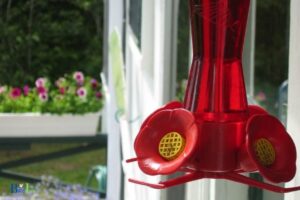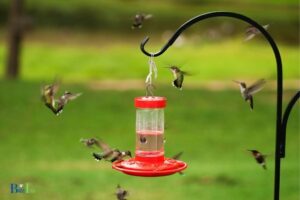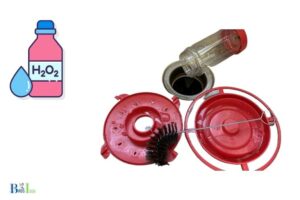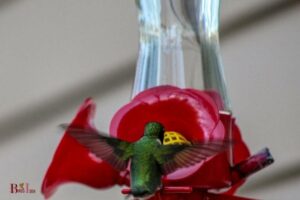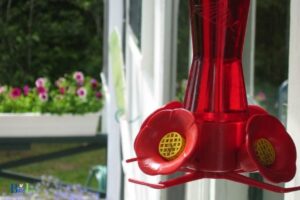How Does Hummingbird Feeder Work: Simple Steps!
A hummingbird feeder works by providing a sugar solution that mimics natural nectar, attracting hummingbirds through bright colors and feeding ports for easy access.
Hummingbird feeders are designed to attract these tiny birds by offering them a high-energy food source in the form of sugar water.
The feeders use brightly colored components and small ports that simulate flowers, making it easy for the birds to feed while hovering in mid-air.
Hummingbird feeders not only offer a convenient and reliable food source for these tiny, high-energy birds, but they also benefit humans by providing an opportunity to observe and appreciate these fascinating creatures.
The feeders’ bright colors and simulated flower design attract these natural pollinators to gardens, promoting healthy plant growth and adding beauty to the environment.
7 Components About Hummingbird Feeder Work
| Component | Function | Description |
|---|---|---|
| Feeder Base | Holds the nectar and provides feeding ports | The base is typically made of plastic or glass and has several feeding ports for hummingbirds to access the nectar. |
| Feeder Reservoir | Stores the nectar | The reservoir is a container that holds the nectar solution, usually made of plastic or glass. |
| Feeding Ports | Allows hummingbirds to access the nectar | Small holes or flower-shaped openings where hummingbirds can insert their beaks to drink the nectar. |
| Nectar Solution | Provides food for the hummingbirds | A mixture of sugar and water, typically at a ratio of 1:4, which mimics the natural nectar found in flowers. |
| Perches (Optional) | Provides a resting place for hummingbirds while feeding | Some feeders have built-in perches for hummingbirds to rest while feeding, but not all feeders include this feature. |
| Ant Moat (Optional) | Prevents ants from reaching the nectar | A small water-filled barrier, usually placed above the feeder, that ants cannot cross to access the nectar. |
| Hanging Mechanism | Allows the feeder to be suspended for easy access | A hook or wire that enables the feeder to be hung from a tree branch, pole, or other suitable location. |
Key Takeaway
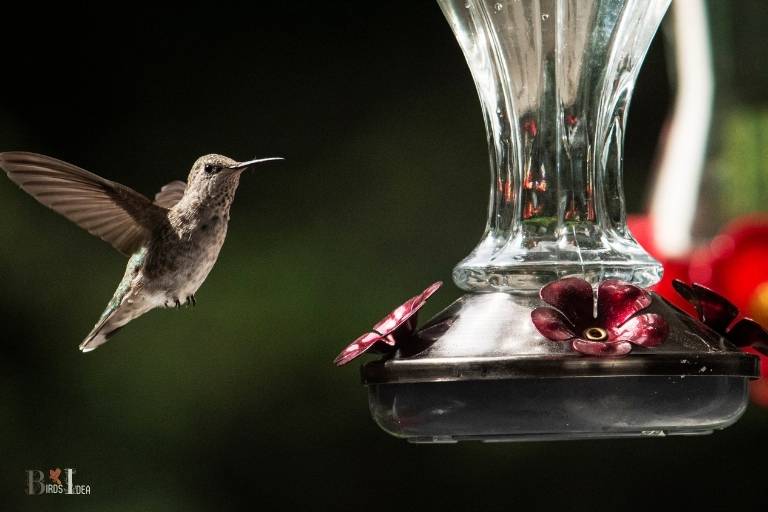
Five Facts About: Hummingbird Feeder Work
Understanding Hummingbird Feeder Construction and Maintenance
Hummingbird feeders are specifically designed to attract hummingbirds by providing them with their primary food source: sugar water or nectar.
These feeders typically consist of a reservoir to hold the solution and a feeding port that mimics the shape of a flower, allowing the hummingbird to access the nectar by inserting its long bill and tongue.
Proper construction and maintenance of hummingbird feeders are crucial to ensure the health of the birds and to keep the feeder sterile, functional, and visually appealing.
Key aspects of hummingbird feeder construction include:
- Materials: Food-grade plastic or glass reservoirs to store the nectar and metal or plastic ports for the feeding station.
- Design: Brightly colored components to attract the birds, usually red, with a flower-like shape on the feeding port to mimic their natural feeding preferences.
- Ant and Bee Barriers: Built-in guards to prevent other insects from accessing the nectar, ensuring that the feeder remains a safe and attractive spot for hummingbirds.
To maintain a hummingbird feeder, these steps should be followed:
Cleaning: Regularly clean the feeder with a solution of warm water and mild dish soap, rinsing thoroughly to avoid leaving any residue. Use a brush to clean hard-to-reach areas.
Refilling: Keep the feeder filled with fresh sugar water or nectar. Replace the solution every 3-4 days, or more frequently in warmer weather, to prevent fermentation and the growth of bacteria or mold.
Monitoring: Keep an eye on the number of hummingbirds visiting your feeder and adjust the amount and concentration of the sugar water accordingly.
What is the Optimal Hummingbird Feeder Design?
The optimal hummingbird feeder design is one that effectively attracts hummingbirds while simultaneously providing them with a consistent and easily accessible source of nectar.
A well-designed feeder should cater to the unique feeding behavior of hummingbirds, protect the nectar from contamination, and be easy to clean and maintain.
The most effective designs mimic the natural feeding preferences of hummingbirds by offering bright colors and flower-like components.
Key features of an optimal hummingbird feeder design include:
- Bright colors: Hummingbirds are attracted to bright colors, particularly red and orange. These colors mimic the flowers they naturally feed from, making the feeder more appealing to them.
- Multiple feeding ports: Providing several feeding ports enables multiple birds to feed simultaneously and reduces the competition for resources.
- Ant moats: Prevent ants and other insects from reaching the nectar by incorporating a moat or guard.
- Bee guards: Prevent bees and wasps from accessing the nectar by adding small barriers or mesh around the feeding ports.
- Easy-to-clean design: Accumulated nectar and debris can contaminate the solution, making it crucial for the feeder to be easy to disassemble and clean.
- Weather-resistant materials: Materials such as plastic, glass, or metal ensure durability in various weather conditions and reduce the chances of contamination.
What Hummingbird Feeder Features Attract Hummingbirds?
Hummingbird feeders are designed to attract these beautiful, energetic, and fascinating tiny birds by simulating the nectar found in flowers they naturally feed on.
Certain features of hummingbird feeders work together to entice and encourage these birds to visit and feed comfortably.
By incorporating these key features, your hummingbird feeder will surely be a popular spot for these flying jewels.
Features that attract hummingbirds to feeders include:
- Bright colors, especially red and orange, which hummingbirds find irresistible.
- Multiple feeding ports, allowing several hummingbirds to feed at once.
- Easy-to-reach nectar reservoirs, with a shallow depth to suit the hummingbirds’ short bills.
- Ant moats and bee guards, to keep insects away from the nectar and ensure a peaceful feeding experience for the birds.
- A sturdy yet visually appealing design that can withstand the elements and blend into the surrounding environment.
What Sets Hummingbird Feeders Apart From Other Bird Feeders?
Hummingbird feeders are specifically designed to attract and feed hummingbirds, setting them apart from other bird feeders.
These specialized feeders cater to the unique feeding habits and preferences of hummingbirds, providing nectar that closely resembles the natural flower nectar they consume in the wild.
Unlike traditional bird feeders that hold seeds or grains for birds to peck at, hummingbird feeders offer liquid nectar in specially designed containers with feeding ports that cater to the bird’s long, slender bills and hovering feeding style.
The key features that set hummingbird feeders apart from other bird feeders include:
- Nectar Reservoir: These feeders hold sugar water or specialized nectar solutions that are designed to mimic the natural nectar found in flowers.
- Feeding Ports: Hummingbird feeders have small ports or tubes that are designed for the bird’s long, slender bills, allowing them to easily access the nectar while hovering.
- Bright Colors: Hummingbird feeders often feature bright red or orange colors to imitate the bright, colorful flowers that hummingbirds are naturally attracted to.
- Anti-drip Design: Many hummingbird feeders are designed to prevent leakage and dripping, ensuring that nectar is not wasted and does not attract unwanted pests.
- Ant and Bee Guards: Some feeders include special guards to prevent ants and bees from reaching the nectar, as these insects can also be attracted to the sugary solution.
In summary, hummingbird feeders are specially designed to cater to the unique feeding habits and preferences of hummingbirds, making them distinctly different from other bird feeders.
By providing a nectar reservoir, feeding ports specifically designed for hummingbirds, bright colors, and anti-drip design and guards, these feeders offer an appropriate and attractive feeding option specifically for hummingbirds.
How Hummingbird Nectar is Made and What You Should Use?
Hummingbird nectar is a simple sugar solution that is made by dissolving sugar in water to replicate the natural nectar found in flowers, which hummingbirds feed on.
This homemade nectar provides essential energy for their rapid metabolism and sustains their hovering flight.
When creating hummingbird nectar, it is crucial to use the right ingredients and ratio to ensure the safety and health of the birds.
Key points to consider when making hummingbird nectar:
- Use granulated white sugar and avoid using honey, artificial sweeteners, or red food coloring
- The ideal sugar to water ratio is 1:4 (1 part sugar to 4 parts water)
- Boil the water to ensure that sugar dissolves completely and to eliminate any bacteria or fungi
How to Prepare Your Feeder for Hummingbird Arrival?
Hummingbird feeders work by providing a readily available source of nectar for hummingbirds to consume.
These feeders are designed to mimic the flowers that hummingbirds naturally feed on, making it easier for them to find and access the sugary, high-energy nectar they need to fuel their rapid metabolism.
To ensure that your hummingbird feeder is ready for their arrival, it’s essential to set it up correctly, keep it clean, and fill it with the right nectar mix.
- Choose a feeder with bright red accents, as hummingbirds are attracted to the color red
- Ensure the feeder is easy to clean and has tightly fitting parts to prevent leaks
- Mix a homemade nectar solution of 1 part sugar to 4 parts water, or use a store-bought nectar mix
- Clean the feeder thoroughly with warm soapy water, and rinse it well before filling to remove any residue
- Hang the feeder in a shady spot, ideally near flowers that hummingbirds frequent
- Check the nectar regularly for cloudiness or mold growth, and clean the feeder as needed
Things to Consider to Make the Most Out of Your Hummingbird Feeder
A hummingbird feeder works by providing a source of nectar specifically designed for hummingbirds.
The feeder typically consists of a reservoir filled with nectar and a feeding port through which the hummingbirds can access the nectar.
To make the most out of your hummingbird feeder, it is important to take certain factors into consideration such as feeder design, nectar recipe, feeder placement, cleanliness, and other features that will attract more hummingbirds.
- Feeder design: Choose a feeder with a bright red design, as hummingbirds are attracted to this color. Opt for a feeder that has multiple feeding ports, perches.
- Nectar recipe: Prepare a homemade nectar solution composed of one part white sugar to four parts water. Avoid using red dye or honey as these can be harmful to the hummingbirds.
- Feeder placement: Position your feeder in a shaded area that is visible and easily accessible to hummingbirds, but also away from potential predators such as cats or large birds of prey.
- Cleanliness: Regularly clean your feeder with hot water and soap to prevent mold and bacteria growth. Replace the nectar every 3-4 days in hot weather or every 5-7 days in cooler weather to keep it fresh.
- Additional features: Plant flowers that attract hummingbirds around your feeder to enhance its appeal and provide a natural source of food.
How to Monitor Your Hummingbird Feeder and Spot Healthy Habits?
Monitoring your hummingbird feeder is essential to ensure the health and safety of these delicate creatures.
A properly maintained feeder will attract more hummingbirds, while also promoting healthy habits.
To monitor your feeder effectively, pay attention to the following aspects:
- Cleanliness: Regularly clean your feeder to prevent mold and bacterial growth. A clean feeder will help keep hummingbirds healthy and encourage them to visit more often.
- Nectar consistency: Ensure the sugar-to-water ratio is properly balanced, as a too-concentrated or diluted solution will not provide the proper nourishment for hummingbirds.
- Refilling the feeder: Keep an eye on the nectar level in the feeder, and refill it as needed. Empty or low feeders will not attract hummingbirds, and they may move on to other sources.
- Surrounding environment: Make sure your feeder is hung in a safe and quiet place, away from predators and other disturbances.
Tips to Keep in Mind when Filling and Cleaning the Feeder
Filling and cleaning hummingbird feeders are essential tasks to ensure that these delightful creatures have a reliable source of nutrition while keeping the feeder free from harmful bacteria or mold.
Proper maintenance creates a healthy environment for the birds and ensures they continue to frequent your feeder.
Here are some essential tips to remember when filling and cleaning your hummingbird feeder:
- Use the right nectar solution: The ideal nectar solution is a mixture of 4 parts water to 1 part table sugar (sucrose). Avoid using honey, artificial sweeteners, or red dye, which can be harmful to the birds.
- Clean the feeder frequently: Regular cleaning is crucial to prevent bacterial growth or mold. Rinse the feeder every time you refill it and clean it thoroughly with a brush, hot water, and mild soap every 1-2 weeks.
- Replace old nectar: Change the nectar at least every 3-4 days or more often in hotter weather to prevent fermentation and spoilage.
- Choose the right location: Place the feeder in a shaded area to keep the nectar fresh for a longer time and prevent rapid evaporation.
What Are the Benefits of Installing a Hummingbird Feeder?
Installing a hummingbird feeder in your backyard or garden not only brings beauty and excitement, but also supports these tiny birds by providing them with a reliable source of food.
Hummingbirds have a high metabolism and need to consume a large amount of nectar to sustain themselves.
By providing them with a feeder, you are helping them meet their energy needs and contributing to the overall health of the species.
In return, hummingbirds can help with pollination, making your garden more vibrant and fruitful.
- Attract and enjoy the beauty of hummingbirds in your backyard.
- Provide a reliable source of food for hummingbirds, supporting their survival.
- Contribute to pollination and improve the overall health of your garden.
- Enjoy a natural and eco-friendly way to control pests, as hummingbirds also feed on insects.
- Experience a closer connection to nature through observing and learning about these fascinating birds.
Remember to maintain your hummingbird feeder, which includes regularly cleaning it and refilling it with the appropriate nectar.
This ensures that the birds have a safe and healthy environment to thrive in. Additionally, you can plant nectar-rich flowers around the feeder to further support hummingbirds with their natural feeding habits.
According to National Geographic, a hummingbird’s wings can flap up to 80 times per second and their heart rate can reach up to 1,200 beats per minute.
birdsidea
FAQ for How Does Hummingbird Feeder Work
How does a hummingbird feeder attract hummingbirds?
What type of nectar should be used in a hummingbird feeder?
Boil this solution for a few minutes to help dissolve the sugar and prevent fermentation before allowing it to cool.
What are some tips for safely caring for hummingbirds?
Conclusion
In conclusion, hummingbird feeders provide us with an incredible opportunity to witness these energetic birds up close and personal.
With proper construction, maintenance, and placement, you can create a welcoming space for these beautiful creatures in your own backyard.
Remember to use the proper mixture of nectar, keep your feeder clean and well-stocked, and monitor the feeder for any unhealthy habits.
By following these tips, you can attract and care for hummingbirds, bringing a splash of color and life into your garden.


